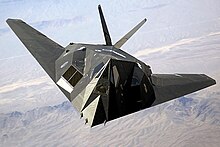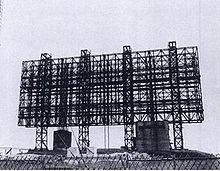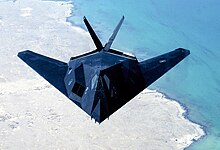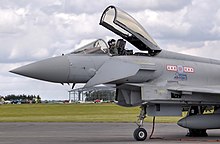Stealth technology
The term stealth technology includes all techniques that make it difficult to locate an aircraft , watercraft or land vehicle . This is done by reducing the emissions emitted or reflected by the object to be located . In the case of aircraft and surface vehicles such as ships, the term mainly refers to those technologies that are intended to make it difficult to locate using radar without the object to be located having to actively emit interference signals itself . Stealth techniques are mainly used in the military sector. Here, for aircraft such as stealth aircraft and stealth helicopters as well as surface vessels such as stealth ships and underwater vehicles such as submarines applied these techniques. Due to popular scientific literature , the anglicisms stealth (German: Heimlichkeit) or stealth technology have become common for stealth techniques . In addition to measures on the property itself, deployment planning is also very important in order to take advantage of the often direction-dependent camouflage properties.
history
Beginnings
Since the beginning of the radar development before the Second World War , there have also been experiments and research work with the aim of protecting against this location method. The first radar absorbing material (RAM) was developed and patented in the Netherlands in 1936. This was an absorber around 2 GHz using carbon dust and titanium oxide . When radar technology became widespread during the Second World War (Germany: Radar Würzburg ; Great Britain established Chain Home ), research into absorber materials was also intensified, especially in Germany and the USA.
One material that was being developed at the time was the Salisbury screen . This RAM was also used in early anechoic rooms. In order to increase the bandwidth, multi-layer structures, the Jaumann absorber, were chosen. The snorkel heads of the German class XXI submarines , for example, were coated with a radar-reflection-reducing rubber-like coating with the code name “chimney sweep”.
The material of this coating, which was developed by Johannes Jaumann together with IG Farben in the spring of 1944, consisted of a sequence of conductive layers, the conductivity of which increases from the outside inwards to the metal wall of the snorkel. The individual layers are separated from one another by dielectric support layers with a very low dielectric constant . An impinging radar wave, the deeper it penetrates, the more and more it is absorbed by this skin. In the ideal case, the energy of the wave is completely converted into heat. Due to the multi-layer structure, the Jaumann absorber is independent of frequency and angle of incidence.
The radar waves are swallowed up like in a swamp - this is why this property was also referred to as a tracking swamp. Other terms are "electrical sump", conductance - or radar sump. A similar principle of action as in the construction of the coating can be found in the wave sump .
After the war, such concepts were forgotten. The radar and electronic countermeasures were more powerful. As a protective measure, the focus was on the ever increasing speed and maximum flight altitude of military aircraft .
Development of the basics
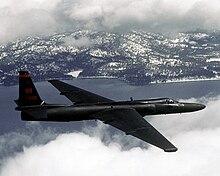

As bombers like the Boeing B-52 could be located with radar at ever greater distances and anti-aircraft missiles and airborne radars became more and more powerful, reducing the effectiveness of enemy radar location became more important. In addition to more powerful electronic countermeasures and surveillance measures, the McDonnell ADM-20 drone was also developed to simulate a B-52 for the opposing radar operator. The drone, although much smaller than a B-52, has the same radar cross-section . This development showed that the radar cross-section of a target does not have to depend on the size of the aircraft.
In 1960 the USAF launched the first stealth technology program. The radar cross-section of a Ryan BQM-34A Firebee drone has been reduced by shielding the air intake of the engines, radar-absorbing material on the fuselage and a special anti-radar paint.
While combat aircraft began to fly through enemy territory at low altitude in order to use natural obstacles to camouflage enemy sensors, this was not possible for spy aircraft . In the case of the Lockheed U-2 "Dragon Lady", for example, attempts were made to avoid a possible defensive fire by flying as high as possible. After the concept had turned out to be unsuccessful, an attempt was made in Project Rainbow to reduce the radar cross-sectional area of the U-2, but this turned out to be ineffective. When a successor was sought, Lockheeds Skunk Works and Consolidated Vultee Aircraft Corporation (Convair) submitted their conceptual designs.
While Convair sought to increase survivability with its Kingfish design by means of a small radar cross-sectional area , its competitor Lockheed relied on the highest possible speed for its A-12 Oxcart design and thus won the competition. Its more powerful version, the Lockheed SR-71 , was finally commissioned. An attempt was made to reduce the radar cross-sectional area by means of shape and re-entry triangles, see below under " Geometric absorbers ". With the associated Lockheed D-21 drone, attention was also paid to a low radar cross-sectional area.
During the Vietnam War , the anti-aircraft missile threat became evident again. Although anti-radar missiles such as the AGM-45 Shrike and the Wild Weasel tactics were developed and used, these were very risky and tied up expensive aircraft in the fight against the enemy air defense instead of attacking tactical targets.
The high losses suffered by the Israelis during the Yom Kippur War also showed that the use of jammers alone is not a satisfactory solution and that low-level flights in contourless desert terrain are only possible to a very limited extent.
Have blue and senior trend
In April 1976, the Defense Advanced Research Projects Agency commissioned Lockheed to develop two airworthy prototypes of stealth aircraft in 60 percent of the planned original size. The development goal was to significantly reduce the effective radar cross-sectional area of an aircraft.
The development was based on the theory of the Soviet physicist Pyotr Jakowlewitsch Ufimzew . The cost was $ 37 million for both aircraft. The program was secret and did not appear officially in any budget. The name Have Blue has no deeper meaning; it was probably chosen at random from a list of possible names for secret programs. The term XST ( Experimental Survivable Testbed ) is also common.
The first machine was completed in November 1977. It should sound out the flight characteristics of the design. The maiden flight took place on December 1st at the test site at Groom Lake in Nevada. During the test phase, the aircraft was flown to a US Army radar system, followed by a chase aircraft. The radar could only detect the pursuer aircraft, which proved the feasibility of the concept. The first flight of the production aircraft Senior Trend (later F-117 ), which was a third larger, took place on June 18, 1981 under strong safety precautions. The aircraft was coated with magnetic absorber material in order to reduce the radar signature in addition to the shape through other measures.
Assault Breaker
With the Cold War at its height, the Warsaw Pact's superiority in tanks and ground forces was now seen as a problem. The Assault Breaker Program was launched in 1978 to fend off a possible attack by the Soviet Union on Central Europe . The aim of this was to use precision-guided ammunition and long-range reconnaissance to destroy ground targets far behind enemy lines. The program laid the foundations for all modern airborne weapons systems used in the conflicts of the 21st century.
In it, LANTIRN containers were developed as a navigation and targeting system for low-level flight operations ( Messerschmitt-Bölkow-Blohm developed the Vebal Syndrome pod for this purpose) as well as cruise missiles that were supposed to bring intelligent submunitions to a Soviet tank formation at low altitude and release them above it. The cruise missiles never went into production; the submunitions were later integrated into the MLRS as Brilliant Anti-Tank (BAT) . Another development related to ammunition containers for combat aircraft, which were supposed to release a swarm of intelligent self-targeting missiles with millimeter- wave radar seekers in the target area . The development was advanced by Hughes with the Wasp "Minimissile", but was discontinued because of excessive costs. The principle was taken up again with the MBDA Brimstone . The CBU-97 Sensor Fuzed Weapon also has its origins in the Assault Breaker program.
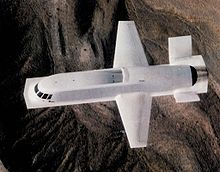
The central element was pave mover . A powerful side-looking airborne radar with electronic beam swiveling was mounted on a General Dynamics F-111 in order to be able to locate Soviet tanks at a distance of over 100 kilometers far behind the front line. Since computers used to have little computing power, the raw data from the radar was sent via a powerful data link to a ground station for analysis. With advances in microelectronics , it became possible to accommodate computers and personnel in an aircraft - the E-8 JSTARS (Joint Surveillance and Target Attack Radar System) was created. On April 30, 1996 it was announced that the Assault Breaker program also had a "black" part. Since the viability of the radar platform was questioned, Northrop developed the stealth aircraft Tacit Blue , which was equipped with a Low Probability of Intercept radar . With the Tacit Blue, faceting of the surface was dispensed with for the first time. The increased computing power of the computer made it possible to continuously curve the surface and still calculate the reflections according to Huygens' principle , which was not possible when the F-117 was developed. Northrop also developed a stealth model for the cruise missile with submunitions, the AGM-137 TSSAM .
Integration in mass systems

When the MiG-31 combat aircraft went into series production with the SBI-16 Saslon radar and weapons control complex in 1981 , fears arose that the high-performance PESA with look-down / shoot-down capability would make the previous cruise missiles relatively easy to intercept. As the successor to the AGM-86 Cruise Missile, the AGM-129 was developed, which was the first cruise missile with stealth technology to go into series production in July 1985.
It was also decided that the next bomber and the next air superiority fighter of the US Air Force should place great emphasis on signature reduction. The “ Advanced Technology Bomber ” program (ATB) resulted in the Northrop B-2 , the “ Advanced Tactical Fighter ” program (ATF) in the YF-22 Raptor and YF-23 Black Widow II . All of these developments used camouflage techniques developed by Northrop in the Assault Breaker program.
A growing problem is that the consistent integration of stealth technology in constructions drives their price extremely high. In the end, only 21 units of the B-2 could be procured, the series production of the F-22 ends after only 187 machines. The same applies to the Zumwalt class ships , of which only three of the 34 originally planned will be procured. Therefore, as part of the Joint Advanced Strike Technology program , attempts are being made to develop the Lockheed Martin F-35 Joint Strike Fighter across the armed forces and internationally in order to save costs through large numbers. Other states only implement certain aspects of stealth technology in their designs in order to save costs. The Eurofighter Typhoon only uses frontal radar absorbing materials and frequency selective surface materials. Instead of internal weapon bays, only indentations were provided for the half-sunk air-to-air missiles. The Visby-class and Skjold-class ships do not use low-probability-of-intercept radar or low-probability-of-detection data links; In terms of materials and shape, however, they are also consistently constructed according to the principles of stealth.
techniques
Objects with stealth properties strive to reduce their signature. Due to the frequency and efficiency, camouflage measures against radar and infrared location as well as detection by enemy electronic reconnaissance are usually implemented. This happens primarily through four properties:
- shape
- Surface material
- Reduction of heat radiation
- LPI radar
Stealth technology is used to varying degrees in most of the world's armed forces today. The invisibility suggested in the media, marketing brochures and trivial literature does not occur and is not the goal. Stealth technology is used to increase the platform's chances of survival by delaying detection by enemy sensors and making it more difficult to attack one's own unit.
shape



In order to avoid reflection of radar energy back to the transmitter, the surfaces are inclined relative to the transmitter or sharp edges are presented. The top priority is to avoid a retroreflector such as B. a corner reflector formed by tail units. Circular cross-sections are avoided, since they form at least one small vertical surface in each direction. In the case of flying objects, a compromise has to be made with regard to aerodynamics. A good shape can reduce the radar cross-section by a factor of 10 to 100. An even higher factor becomes difficult, as Huygens' principle states that even an extremely inclined plate radar energy back to the transmitter, only considerably less than when the signal hits at right angles . Radar-absorbing materials are therefore essential for a further reduction, but these are usually less effective against low-frequency radars, see below in the section Radar-absorbing materials .
If a radar beam hits an inclined surface, the E-field component of the wave directed perpendicular to the surface travels along the surface at the speed of light. There is hardly any backscatter at the point of impact. At the end of the run, this energy is radiated back into the room; a person who could “see” in this frequency range would perceive a kind of Elm's fire there . Stealth units therefore have surfaces that are as smooth as possible without protruding antennas and gaps. Attempts are therefore made in aircraft to omit leading edge flaps and to construct air inlets so that they cannot be adjusted, which is not always possible due to the required flight performance. Weapons are transported internally and shafts are opened when they are fired. Since a weapon bay also represents a gap, its edges are inclined or jagged in order to dissipate the energy.
Naval guns should not envelop only with an angular cladding radarabsorbierendem material (RAM) the tube, as energy is radiated into the space at the tip also, but to accommodate the pipe possible in a closed housing, as in the picture on the right above in the Visby class to see.
While early stealth designs (F-117) placed great emphasis on dispersion in all spatial directions, more recent developments endeavor to arrange as many edges as possible in the same direction so that the radar cross-section only increases sharply in a known, small angular range. Additionally or alternatively, where this is not possible or where transitions interrupt surfaces, these edges are interrupted by serrations in order to dissipate radar energy. The wavelength of the radar must be smaller than the periodicity of the spikes. In general, a relatively large radar cross-section perpendicular to the longitudinal axis of the object remains unavoidable. Should measures be taken to increase this in favor of other directions, this is a compromise worth considering.
The surface must be conductive when closed. Windows and cockpit canopies are coated with gold (gold-colored) or indium tin oxide (greenish). The enclosure must transfer or dissipate the E-field component into the structure in order to prevent undesired radiation of radar energy to the environment.
The nozzle ends are designed, like other unavoidable interruptions, angular or jagged (example: F-35); alternatively, the bottom of the nozzle can be extended (as seen on the Northrop YF-23 in the picture on the right) to make it more difficult to see from the ground. In the F-117 , the engine outlet was also designed in the form of a narrow horizontal slot in order to achieve rapid mixing of the hot exhaust gases with the ambient air. Further IR camouflage measures are described below.
Frequency selective surface
Frequency Selective Surface (FSS) materials are used when the material of the radome has to be transparent for the electromagnetic waves of the own radar or communication antenna, but other frequencies and polarizations are to be reflected or absorbed in order not to enlarge the radar cross-section. This makes use of the fact that the refractive index as well as the degree of reflection and transmission of electromagnetic waves at a dielectric interface change with different frequencies and polarizations . The basics of this are explained in the articles Fresnel's formulas and prism spectrometers . CA-RAM is also processed in these radomes.
Radar absorbing materials
target
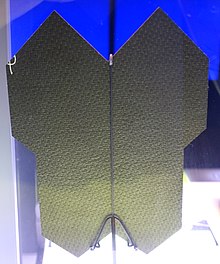
Radar absorbing materials (RAM) are necessary to reduce the radar cross-section further than is possible due to the shape alone. In this way, radar cross-sections of birds or insects can be achieved in aircraft. It should be noted that RAM has a limited bandwidth and absorption capacity. This changes depending on the frequency and angle of incidence of the radar energy. The aim of the design is to produce the broadest possible material with low density and thickness, high absorption capacity and low angle dependence. Costs and maintenance also play a role.
This can become a problem if an object is irradiated with a radar whose wavelength lies outside the frequency range of the radar-absorbing material. A target with a radar cross-section of 0.01 m², which is coated with radar-absorbing material with 20 dB attenuation, has a radar cross-section of 1 m² outside the absorption range. If the coating is ineffective, the signature reduction only takes place via the shape of the object. An obvious problem is that many RAM in the frequency range below 2 GHz lose a lot of absorption power, which is why there is the saying among radar reconnaissance "There is nothing invisible below 2 GHz". Coatings that also work in the range below 2 GHz are usually weaker than higher-frequency ones.
To get a better feeling for radar absorbing materials, a table is shown here as an example. It applies to a South Korean broadband foam absorber. The top line shows the radar frequency and the left column shows the thickness of the foam. The decibel values provide information about the attenuation, −20 dB means that the effective radar cross-sectional area has decreased by a factor of 100. It should be noted that the angle of incidence of the radar radiation remains the same.
| thickness | 2 GHz | 6 GHz | 10 GHz | 14 GHz | 18 GHz | 22 GHz | 26 GHz | 30 GHz | 34 GHz | 38 GHz | 42 GHz | 46 GHz | 50 GHz |
|---|---|---|---|---|---|---|---|---|---|---|---|---|---|
| 5 mm | 0 dB | 0 dB | −2 dB | −6 dB | −10 dB | −14 dB | −17 dB | −19 dB | −19.5 dB | −20 dB | −20 dB | −20 dB | −20 dB |
| 9.5 mm | −1 dB | −7.5 dB | −14 dB | −20 dB | −20 dB | −20 dB | −20 dB | −20 dB | −20 dB | −20 dB | −20 dB | −20 dB | −20 dB |
| 12 mm | −3 dB | −9 dB | −17 dB | −21 dB | −22 dB | −21.5 dB | −20.5 dB | −20 dB | −20 dB | −20 dB | −20 dB | −20 dB | −20 dB |
| 19 mm | −4 dB | −10 dB | −18 dB | −22 dB | −23 dB | −22.5 dB | −21.5 dB | −21 dB | −21 dB | −20.5 dB | −20 dB | −20 dB | −20 dB |
| 25 mm | −5 dB | −14 dB | −20 dB | −23 dB | −23.5 dB | −23 dB | −22.5 dB | −22 dB | −22 dB | −22 dB | N / A | N / A | N / A |
| 50 mm | −11 dB | −21 dB | −24 dB | −25 dB | −25 dB | −24 dB | −24 dB | −24 dB | −24 dB | −24 dB | N / A | N / A | N / A |
The following things can be observed: The highest absorption values occur in the range from 10–18 GHz; Below 10 GHz, the foam loses a lot of its absorption capacity, but this can be partially compensated for by increasing the thickness. The behavior of thin foams at frequencies above 34 GHz is also interesting, where the absorption power remains constant at −20 dB and is independent of the thickness. The following is a schematic listing of RAM design principles.
Salisbury Screen
The Salisbury screen consists of three layers: a metallic underlayer, a dielectric material with a thickness of a quarter wavelength of the resonance frequency and a thin, lossy top layer. When the radar wave hits the deck plate, it is split into two waves of equal intensity. One is reflected on the surface, the other dips into the material and is reflected on the metallic underlayer. The distance ensures a phase shift of the second wave by 180 ° when it leaves the material. The destructive interference does not reflect energy back to the transmitter. The dielectric can consist of balsa wood or PVC, for example. The bandwidth of such an arrangement is ± 5%. It can be increased if several cover plates and dielectrics are stacked on top of one another, which also reduces the tilt sensitivity. The electrical resistance of the cover plates decreases exponentially towards the lower layer. This arrangement is also called a Jaumann absorber .
Magnetic absorbers
While a Salisbury screen structure places a lossy material at the point where the electric field component has a maximum, a magnetic material can also be positioned at the point of the maximum H field. When a wave hits an obstacle, the H-field on the surface is maximal. This is used in magnetic RAM (also called MAGRAM). The thickness of these layers is about λ / 10, which is significantly less than in dielectric RAM. Carbonyl iron or ferrites are usually embedded in rubber in these RAMs . The small dipoles strive to align themselves with the changing field lines; the resulting torque transfers energy to the material, see also relaxation (natural science) . More exotic barium hexaferrite or titanate substituted with cobalt can also be used as magnetic material, and siloxanes and neoprene as matrix material . The frequency range is approximately between 2 and 46.5 GHz, depending on the amount of cobalt. MAGRAM was used on the Lockheed F-117 .
Dallenbach Layer
Another dielectric RAM, but it's homogeneous. Here, graphite powder and titanium oxide are mixed in a binding medium, for example polyurethane foam . The amount of graphite determines the dissipation, while the amount of titanium oxide influences the permittivity . This allows the required thickness of the material to be set; A metal is used as the back plate. Instead of the two additives, aluminum flakes or radar-absorbing chaff with a length of about 50 µm can be mixed into a solid binder. The frequency range is then around 10 GHz to 100 GHz with a reduction in the radar cross-section by up to 30 dB.
Circuit analog RAM
With Circuit-Analog-RAM (CA-RAM) layers containing conductive shapes are stacked on top of one another. The shapes can consist of small parallel rods, crosses, Jerusalem crosses , wires, braids or the like. The geometric shapes are adapted to the wavelength to be absorbed. The molds are poured into a matrix, the resulting individual layers are stacked separately with dielectrics. If the layers contain unidirectional elements, for example the rods or fibers per level are only oriented in one direction, they are alternately rotated by 90 ° during stacking in order to make the composite polarization-independent . The advantage of the CA-RAM is that the choice of shape means that the material can be adapted to any wavelength and bandwidth, the disadvantage is the very high manufacturing costs.
µ = ε absorber
Thick materials for which the relative permeability and relative permittivity are the same (µ = ε) are called µ = ε absorbers . With them, much of the energy is absorbed by the material before it reaches the back plate. Although the values are mostly frequency-dependent, ferrites have been developed in which these values are frequency-independent in a certain frequency range.
Low density absorber
Low density absorbers work like the µ = ε absorber, only that here µ = ε ≈ 1, which almost corresponds to the values for air or vacuum . These requirements are mostly met by low-density materials. The sample material Spongex (1973) was 5 cm thick and worked in a frequency range from 2.4 to 10 GHz with an absorption of up to −20 dB. The lowest frequency of 2.4 GHz could be further reduced by using a thicker material.
Inhomogeneous absorber
The inhomogeneous absorber should have as little discontinuity as possible at the transition to the environment (ie µ, ε ≈ 1); However, with increasing installation depth, the losses should increase in order to absorb the electromagnetic energy as completely as possible. For this purpose, different layers with different loss values can be stacked or a homogeneous material can be modified accordingly. The construction depth depends on the lowest wavelength to be expected.
For this purpose, a foam can be dipped into aqueous graphite solutions of various concentrations. The foam is compressed and expanded in the solution to absorb the graphite. Alternatively, polystyrene with different proportions of graphite is also possible. The absorption power is around −20 dB and is retained even at steep angles of up to ± 70 °.
Geometric absorber
The difficulty of producing different layers with different properties led to geometric absorbers (Geometric Transition Absorbers). A material with constant properties is used, but given geometric shapes in order to increase the absorption coefficient in the direction of the metallic back plate. Steep wedges, pyramids and conical bodies are used for this, as they are also used in absorber chambers . In aircraft, they are used along the wing edges, with the cavities between the spikes being filled with an absorbent material of low permittivity. These absorbers are very dependent on the angle.
Chiral materials
Chiral materials consist of an isotropic matrix in which identical microstructures such as microhelices are embedded in a random orientation . The geometric dimensions and material properties of the microstructures determine the electromagnetic parameters of the radar-absorbing material. The backscattering of these coatings depends on the polarization. They are used to give Salisbury screens and Dallenbach layers greater bandwidth and absorption capacity. With a thickness of λ / 5, approximately 15-25 dB can be achieved.
Radar absorbing structures
Since the coating of the surface means extra work, extra costs and extra weight, the production of radar-absorbing structures (RAS) has been used in some cases in order to save costs and weight. Ferrite, graphite, CA-RAM structures or layers of radar-absorbing materials are mixed into the polymer matrix of the fiber-plastic composite . In some cases, bismaleimides are also used as a matrix. Stealth ships are mostly made of radar-absorbing structures (RAS), as the extra effort and costs of the coating would otherwise be too high.
Examples of this are the ships of the Visby class and the Skjold class .
Infrared camouflage

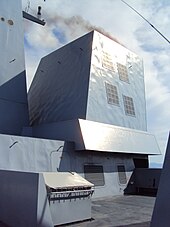
Due to the widespread use of infrared sensors and their continuous improvement, methods have also been developed to better camouflage oneself against them. Each object emits thermal radiation , which is picked up by the array of photo receivers in a thermal imaging device . Due to atmospheric absorption, only wavelengths of 3–5 µm and 8–14 µm are possible. Since military units are mostly powered by heat engines, they are usually hotter than the environment and therefore easy to discover.
cooling
The simplest method of infrared camouflage is to cool the object's hot exhaust gas jet, which is the main cause of IR emissions, so that it emits less energy according to the Stefan-Boltzmann law . In ships, seawater is injected into the exhaust gas jet; in aircraft, mixing with ambient air is common. The Eurocopter Tiger's exhaust jet is mixed with fresh air before it leaves the engine nozzle; the Northrop B-2 uses the cool flow of the boundary layer separator for this , see the picture on the right.
Selective emissivity
With selective emissivity technology , coatings reduce the emissivity ε in the relevant wavelengths. The Planckian radiation spectrum of a body is modified in this way; Instead of the usual hump curve, the curve course is adapted to requirements. So at the wavelengths 3–5 µm and 8–14 µm valleys will appear in the curve and thus fewer photons will be emitted in these frequency bands, making the object appear colder. This is the most common application of IR camouflage techniques today. By using different coatings in different places, a pattern of spots or the like can be created in the infrared in order to better camouflage yourself in the terrain.
IR / RAM coatings
IR / RAM coatings try to achieve radar absorbing properties with low emissions in the relevant infrared wavelength ranges. Only dielectric IR coatings can be used here. Such materials consist of an IR-camouflaging top layer and an underlying RAM or a quasi-homogeneous mixture of RAM and IR material. A coating from IBD Deisenroth Engineering , for example, achieves an absorption of approximately −30 dB in a frequency band of 8–18 GHz; the quality of the IR camouflage has not been published. In the case of IR / RAM coatings, more exotic variants such as charred bamboo fibers coated with silver are also conceivable.
Light cascade
Laser rangefinder send out a temporal light pulse in the infrared spectrum, which is reflected on the target object and runs back to the transmitter. The maximum measurable distance depends, among other things, on the reflectivity of the target for the wavelength of the laser. To reduce this, the concept of the light cascade was developed. Different molecules are combined, with the absorption band of one overlapping the emission band of the other. So if a wavelength A hits the material, some kind of molecule will absorb it and at wavelength B will emit the energy again. Another variety will absorb wavelength B and emit in region C and so on. In this way, the energy of one wavelength can be captured and emitted again in another. The method may also be suitable for infrared camouflage.
Low Probability of Intercept Radar
Conventional radar devices can be located from a far greater distance from which they are able to locate the target object themselves. Low Probability of Intercept (LPI) radar devices try to hide their emissions so as not to be located by enemy radar warning systems or electronic reconnaissance (ESM) or not to provide target illumination to enemy guided weapons such as the AGM-88 HARM anti-radar missile.
This is done using a number of methods, some of which can also be combined with one another. Conventionally working radar warning receivers, which look for regularly occurring pulses of high spectral power density, are not able to locate LPI radars. LPI radars allow stealth units to actively search for enemies without making their presence and position easily identifiable. So they could see the opponent themselves without being seen.
An attempt is made to achieve the highest possible sidelobe attenuation , since sidelobe emissions increase the likelihood of the radar warning receiver responding even though the beam was not aimed at the radar warning receiver. Periodicity should be avoided in the illumination; This is achieved with an irregular search pattern in which all parameters of the transmitted pulses are changed in quick succession to confuse radar receivers.
Omnidirectional LPI (OLPI) radars, which do not carry out a scan and transmit with a very wide beam (large opening angle), but receive with an antenna with high directivity, take a different approach . This method increases the lighting time and avoids regular strong pulses. However, a high computing capacity is necessary because it is difficult for the transmitting radar to distinguish the echoes of its own transmission pattern from background noise and other natural disturbances. As with all LPI radars, the effectiveness of this mode is highly dependent on the processing capacity of the signal processing.
It is also possible to use “exotic” carrier frequencies that are usually not taken into account by radar warning receivers. Frequencies below 0.5 GHz and above 20 GHz are conceivable. For example, the AH-64 Apache's AN / APG-78 Longbow Radar uses a frequency of 35 GHz. Another possibility is the use of frequencies with 22, 60, 118, 183 and 320 GHz, since the atmospheric attenuation is highest there. However, such radars have a very limited range.
Most radar detectors interpret an increase in output as an approaching radar and, on the other hand, a decrease in output as a removal, so the output of the radar is constantly adjusted, which can irritate the radar detector. This method is used in the French Crotale . The target is activated and the transmission power is reduced to the minimum signal-to-noise ratio . The ESM sensors interpret the radar as being far away and classify it as a low priority threat.
An important LPI technique is the spread spectrum of the transmission pulse; here the power is distributed over a large bandwidth so that narrow-band sensors can only receive part of the power. This worsens the signal-to-noise ratio in radar warning receivers and thus the detection range.
An analogous method to get by with a lower spectral power density is pulse compression ; Without precise knowledge of the signal shape, detection is hardly possible because the signal is practically drowned in the background noise. The pulse compression method enables longer transmission pulses with good distance resolution and low pulse power. However, longer transmission pulses limit the minimum measurable distance, since nothing can be received in transmission mode. This is why some LPI radar devices use separate transmitting and receiving antennas, as powerful radar signal processors can compress a strong echo signal from close range from a pulse that has not yet been fully received. Another analog method of band spreading is FM modulated continuous wave radar .
For digital method of band spreading see Direct Sequence Spread Spectrum . Since the reflections take place asynchronously and several echoes are superimposed at the receiver, long spreading sequences with low autocorrelation are required; in contrast to the Barker code , these are not optimal.
Low probability of data link detection

In the case of a low-probability-of-detection (LPD) data link, an attempt is made to process data transmission between military units without the enemy noticing. Directed data links are used for this purpose, for which sender and receiver use at least two antennas for simultaneous sending and receiving. These are phased array antennas , which are usually integrated into the surface and should have the highest possible antenna gain and small side lobes. Due to the strong directional effect, the possible data rate is also greatly increased. The signal-to-noise ratio at the receiver should also be as low as possible in order to prevent detection by opposing sensors. The transmission signal is transmitted as phase modulation of pseudo-random noise using cyclic code shift keying (CCSK) so that possible opponents who are in the directional characteristic of the transmission antenna do not notice the data transmission . The difficulty with LPD data links is to keep the bit error rate as low as possible.
See also
literature
- Allan Douglas English / The Royal Military College of Canada: Changing Face of War: Learning from History. 1998, ISBN 0-7735-1723-5 . Pp. 197–212: Stealth Technology: A Revolution in Air Warfare?
Web links
- Trends in radar absorbing materials technology; Computational Electromagnetics Lab, Aerospace Electronics & Systems Division, National Aerospace Laboratories. springerlink.com
- Microwaves101.com, Fundamentals of EM waves
- Microwaves101.com, Radar cross-section physics
- Microwaves101.com, Radar absorbers
- Cyclic Code Shift Keying: A Low Probability of Intercept Communication Technique (PDF; 1.1 MB)
- An Introduction to RF and IR Stealth Technology, Aerospace Computational Modeling Laboratory (PDF; 3.4 MB)
- Stealth coatings technology section, Laboratoire de Physique du Rayonnement et de la Lumière (Confidential, still online?) (PDF; 2.8 MB)
- RADAR ABSORBING MATERIAL DESIGN, Naval Postgraduate School
- DETECTION AND JAMMING LOW PROBABILITY OF INTERCEPT (LPI) RADARS, Naval Postgraduate School (PDF; 2.5 MB)
- ARC Technologies Inc.'s range of absorbent materials
- Air Power Australia, PRECISION GUIDED MUNITIONS The New Breed
Individual evidence
- ↑ Kühnhold, ways of electrical camouflage, p.15 PDF, 1 MB
- ↑ Camouflaging and strong elimination of radar radiation
- ↑ 1960s AQM-34 Ryan Firebee (USA) . In: pbs.org . Retrieved January 14, 2015.
- ^ Translation of the term on leo.org
- ↑ An Introduction to RF and IR Stealth Technology , page 14 ( Memento of February 21, 2014 in the Internet Archive ) (PDF; 3.4 MB)
- ↑ http://www.wrdavis.com/docs/brochures/NavalIR_Hardware.pdf ( page no longer available , search in web archives ) Info: The link was automatically marked as defective. Please check the link according to the instructions and then remove this notice.
- ↑ http://proj3.sinica.edu.tw/~chem/servxx6/files/paper_3029_1231998964.pdf ( page no longer available , search in web archives ) Info: The link was automatically marked as defective. Please check the link according to the instructions and then remove this notice.
